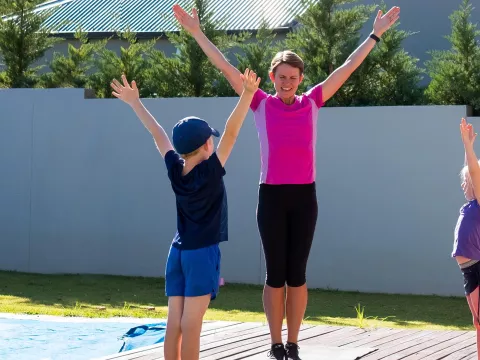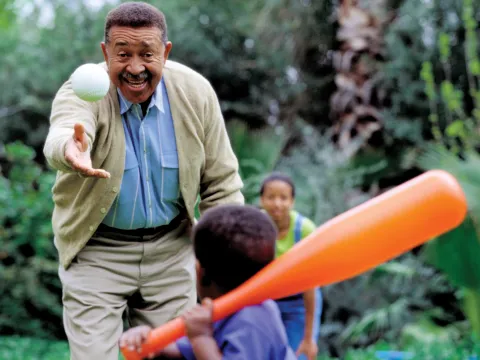- AdventHealth

This school year, many school districts and parents are choosing virtual learning for their children. While online learning reduces the risks of spreading COVID-19, another semester at home can also be challenging for parents and students.
For one, kids need time and space to stay physically active like they would in physical education (PE) class, too. With a bit of planning and these tips, you can help ensure your kids can get the physical activity they need while learning at home.
Why Kids Need Activity
Getting enough exercise and activity is an important way for people of all ages to stay healthy. According to the Centers for Disease Control and Prevention (CDC), kids ages 6 and older need at least one hour of exercise a day. Children younger than age 6 should be active throughout the day.
Exercise can help children and teens:
-
Build focus and memory
-
Build healthy bones and muscles
-
Develop positive self-esteem and promote good mental health
-
Develop coordination and motor skills
-
Improve strength and endurance
-
Reduce the risk of being overweight
With this in mind, we want you to feel empowered to help your kids get the exercise they need while learning from home.
First, Create a Daily Schedule
When thinking about virtual learning, try to mimic your children’s usual school day, including taking regular breaks. Setting up a daily schedule will help everyone get on the right track. Determine a schedule for each member of your family and post it somewhere in your home for everyone to see.
Keep these tips in mind:
-
Find time after schoolwork ends for a longer exercise session
-
Schedule time for a lunch break, as well as morning and afternoon snacks
-
Set aside time for short activity or movement breaks
-
Try to go to bed at the same time every night so that your family gets enough sleep
-
Try to wake up, have breakfast and get dressed at the same time every day
Set Short Activity Breaks
Include plenty of breaks in the day. Think mini recess periods. The number of breaks will depend on your children’s ages. Younger children may need an activity break after 20 minutes of learning, while older children and teens might need to take breaks only between subjects.
Use this break time to stretch, play or walk around the house or outside, and let your family members take turns choosing an activity each day or week. These ideas can get you started.
Have a Stretching Session
For a quick break, do a family stretching session. You can even do this from your desks. Try rolling your shoulders back and then releasing them. Or simply close your eyes for a few minutes to give them a break.
Get Outside
Take a quick walk or bicycle ride around your yard or neighborhood. Just be sure to follow social distancing rules recommended by the CDC when you’re outside.
Play a Game Together
Younger kids might enjoy a quick round of an active game such as tag, Simon Says, follow the leader or tug of war.
Use Your Play Equipment
If you have swings, a trampoline or playground equipment, let your children play as they would at school recess. Or, invest in some inexpensive equipment, such as hula hoops, exercise balls, a Frisbee or jump ropes.
Play Ball
Grab a few minutes of catch, basketball, soccer or another ball game.
Try a Scavenger Hunt
Have a five- or 10-minute scavenger hunt, either around the house or outdoors. Simply create a list of common items for your children to find, and see how many they can gather in the allotted time.
Schedule Longer Exercise Sessions
In addition to short breaks, try to schedule a longer activity break in your family’s daily routine, perhaps after their school day is done. Each family member should aim for at least 60 minutes of activity every day. Keep in mind, you can break this time up into smaller segments.
For bonus activity points, here are some ideas for keeping your kids active for longer stretches:
Set Up a Schedule for Chores
Vacuuming, dusting, cleaning the kitchen and bathrooms, mowing the lawn and taking out the trash are all ways to keep kids busy. Schedule age-appropriate chores for each member of your family at least once a week. Not only will you keep your kids active, but you’ll enjoy a clean house as well.
Practice Sports
If you have athletes in your family — or your kids play a sport as a hobby — encourage them to practice drills. Even if they can’t practice for real, there are likely ways to stay in shape for their eventual return to the court or field, such as running or lifting weights. If your child’s team is practicing as a group or playing games, make sure to read and follow the CDC’s guidelines for playing sports before they join in.
Find a New Sport
If your child is unable to practice or continue their particular sport right now, encourage them to try something else, such as running or bicycling, to stay fit. You can also ask your child’s coach or trainer for ideas on activities to help build individual skills and conditioning for their sport.
Use Online Apps and Videos
With so many people at home, there are now more exercise videos and apps available than ever before. For example, you can find all types of exercise videos of varying lengths and intensities for free on YouTube.
We’re Here to Support You and Your Family
As you continue to navigate a new sort of school year, know that we’re here to help. Find more articles, ideas and updates like this one on the back-to-school section of our Coronavirus Resource Hub. If needed, you can also find a pediatric provider near you to get your kids the health care they need to finish the school year strong.




